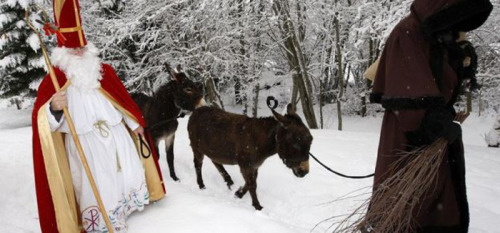Tomorrow, December 6th, is St. Nicolas’ day, which means that tonight, children will be putting out their shoes in the hope that when they wake up in the morning, they will find their footwear filled with candies.
Good children, that is.Â
Naughty children, on the other hand, may find themselves whipped by le Père Fouettard (or Hans Trapp in Alsace & Lorraine) – St Nicolas’ faithful companion as he goes on his rounds on December 6th. While St Nicolas rewards good children with gifts, le Père Fouettard dishes out lashes and pieces of coal.
Le Père Fouettard
Sinister-looking, and somewhat dishevelled, le Père Fouettard is usually dressed in dark robes – sometimes mirroring those of St Nicolas – and has a long beard and scraggly hair. He usually carries a whip or a large stick – sometimes, a bundle of sticks – and on his back, he very often has a wicker basket in which to put really naughty children. He also has a dark face; some claim it’s because of a burned effigy of Charles V (see below), and some because, like Zwart Piet in The Nederlands, he goes down the chimney with St Nicolas.
The origin of the Father Whipper seems to begin as far back as the mid-twelfth century. The story goes that three boys from a wealthy family were on their way to a church school, when they were kidnapped by an innkeeper, who later, with the aid of his wife, kills them and steals their money. In some versions of the story, the boys end up as the main ingredient in a stew as well. However, all is not lost because St Nicolas discovers what has befallen the boys, and resurrects them. Realising the error of his ways, le Père Fouettard then repents, and joins St Nicolas as he travels the country to atone for his sins.
Another version of the story, albeit four centuries later, says that in 1552, during the Siege of Metz, an effigy of Charles V, the Holy Roman Emperor, was burned and then dragged through the city. Around the same time, the tanners guild created a character who was bound in chains, and punished naughty children by whipping them. These two events happened around St Nicolas Day, and over time, both the effigy of Charles and the tanners’ character became intertwined, resulting in the individual we now know as le Père Fouettard.
In the 1930s, le Père Fouettard seems to have decided to go on his own travels, and ended up in the USA, where he was known as Father Flog (or Spanky in some areas). While he still whipped bad children (and cut out the tongues of liars), in the US, he was not associated with Christmas. He also had a female companion, Mother Flog.
Hans Trapp
In the Alsace and Lorraine regions, Hans Trapp is the resident boogeyman. He has more or less the same characteristics as le Père Fouettard, and indeed as the Alpine boogeyman, Krampus, or the German, Knecht Ruprecht.
All over Alsace, as St Nicolas Day approaches, you will hear parents telling their children that, “Hans Trapp is coming, Hans Trapp is comingâ€, so they’d better buck their ideas up, or else!
Hans Trapp’s story, however, is vastly different to le Père Fouettard, and seems to have been derived from the story of the real-life Hans von Trotha, who waged war against his local abbot, wantonly destroyed villages, and was finally excommunicated by Pope Alexander VI (Rodrigo Borgia). As an aside, in return, von Trotha accused the Pope of debauchery, which gave rise to some of the controversy surrounding the Borgia family.
The legend of Hans Trapp tells us that during the 15th century, there lived a cruel, vain, and arrogant nobleman called Hans Trapp who lived a life of lawlessness and depravity. His one goal in life was the accumulation of wealth and power, and to this end, he used his powers of black magic to make a pact with Satan.
The Church finally got wind of Hans Trapp’s misdeeds, and so had him arrested and taken to Rome, whereupon the Pope excommunicated him, and confiscated his lands and fortune. Returning home to Alsace, Trapp was shunned by the locals, and was forced to live in the wilderness, away from society. This forced isolation eventually sent him insane, and he spent his time cooking up plans for revenge and becoming more and more devoted to Satan.
Such was his madness that eventually, Hans Trapp took to roaming the countryside, looking for human flesh to eat, often disguising himself as a scarecrow in order to catch unwary passers-by. One day he caught a shepherd boy, killed him, and roasted him over an open fire; however, before he could take a bite, a bolt of lightning struck him on the head… and killed him.
Since then, parents have used the story of Hans Trapp to scare their children into behaving themselves.
These days, le Père Fouettard and Hans Trapp still accompany their respective St Nicolases, calling in at people’s houses, to see which children have been naughty, and which have been nice. Of course, now, the children aren’t actually whipped but they do sometimes still receive pieces of coal, while the good children receive candy. In some areas, St Nicolas’ companions leave a bundle of twigs, which parents then display throughout the year as a reminder to their children to behave themselves.
So… who will you be getting a present from, this St Nicolas Day?
